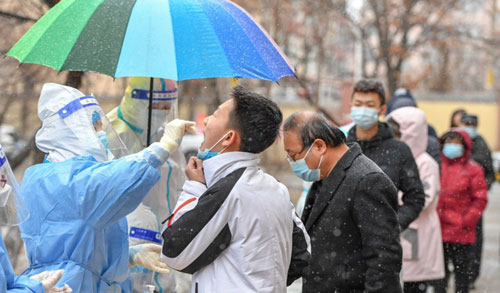The cities of Changchun and Jilin in Northeast China’s Jilin Province have sealed off all residential communities and launched three-day citywide nucleic acid testing as the epidemic situation in Jilin Province continues to worsen, with nearly 1,500 new infections being recorded on Saturday.
With more stringent measures in place and more rounds of nucleic acid testing to find potential virus carriers, health experts estimated that the latest out-break in the province might see a turning point in the middle of April.
The two cities, which have been hit hardest by the coronavirus, upgraded prevention measures over the weekend. The government of Jilin city, with more than 2 million people, announced on Sunday that it will put all residents under “static management” from Monday at midnight to Friday, which means residents cannot step out of their houses or residential compounds during this time. Residents in the control area can order daily supplies online every two to three days.
Changchun also updated restrictions on residen-tial communities on Saturday. Except for medical staffers, community workers, volunteers and other anti-epidemic workers, all residents are required not to leave their residential compounds during the three-day mass testing, said the local government.
Those under quarantine at home can have daily necessities delivered by community workers and volunteers to their doors.
Other residents can go to certain sites especially set for picking up things they ordered within the residential compounds in groups, under the organi-zation of their communities, said the Changchun government’s announcement.
Jilin Province reported 1,191 new local con-firmed cases and 303 asymptomatic patients on Sunday, with most cases concentrated in its capital city Changchun and Jilin city.
As the region hit hardest by the latest outbreak in China, Jilin Province has recorded more than 10,000 infections since March 1.
Jing Junhai, Party chief of Jilin Province, said during a conference on Saturday night that the prov-ince is at the key stage of a tough battle against the virus.
“The anti-epidemic work in Jilin has entered the last stand, where all prevention and control measures have to be conducted in an orderly, powerful and effective manner so as to dynamically clear the cases to zero as soon as possible,” Jing said.
The rapid expansion of the outbreak in Jilin is mainly due to the spread of the dominant Omicron mutant strain in the region, which makes it harder to trace the origins of infections as there are more pa-tients with no symptoms who can quickly spread the virus to others, Zhang Boli, a Chinese epidemiologist and academician with the Chinese Academy of Engineering, told People’s Daily on Saturday.
Zhang predicted the curve of the Jilin outbreak might flatten in the middle of April, yet “stable” doesn’t mean absolutely no cases but no new infec-tions within the community.
“Seven days after finding no new positives, then the province can open up completely,” he said. Jilin provincial government officials called for the supply of goods and materials for residents to be ensured, as well as the further improvement of the efficiency of nucleic acid testing, and acceleration of obtaining and renovating isolated rooms for COVID-19 patients.
Zhao Jiyang, a staffer of one of the 60 stores of the Eurasia supermarket in Changchun, told the Global Times on Sunday that people can either order vegetables, fruits and other basic foods through group purchases or order them via the WeChat mini app, where they can buy many other kinds of goods, such as diapers for babies.—Agencies










